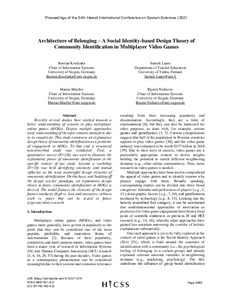| dc.contributor.author | Müller Marius | |
| dc.contributor.author | Laato Samuli | |
| dc.contributor.author | Kordyaka Bastian | |
| dc.contributor.author | Niehaves Bjoern | |
| dc.date.accessioned | 2022-10-28T13:53:56Z | |
| dc.date.available | 2022-10-28T13:53:56Z | |
| dc.identifier.isbn | 978-0-9981331-4-0 | |
| dc.identifier.issn | 2572-6862 | |
| dc.identifier.uri | https://www.utupub.fi/handle/10024/168137 | |
| dc.description.abstract | <p>Recently several studies have worked towards a better understanding of reasons to play multiplayer online games (MOGs). Despite multiple approaches used, understanding of the topic remains incomplete due to its complexity. This study constructs an explanatory design theory of community identification as a predictor of engagement in MOGs. To that end, a structured multimixed-method study was conducted. First, a quantitative survey (N=236) was used to illustrate the explanatory power of community identification in the specific context of our study. Second, a workshop (N=10) was held identifying similarity and mutual influence as the most meaningful design elements of community identification. On this basis, and building off the design science paradigm, and assumptions from the contrast model and interactive richness, an explanatory design theory to foster community identification in MOGs is derived. The model features the elements of the design factors similarity (high vs. low) and interactive richness (rich vs. poor) that can be tested in future (experimental) research.<br></p> | |
| dc.language.iso | en | |
| dc.title | Architecture of Belonging – A Social Identity-based Design Theory of Community Identification in Multiplayer Video Games | |
| dc.identifier.url | http://hdl.handle.net/10125/71276 | |
| dc.identifier.urn | URN:NBN:fi-fe2021042824145 | |
| dc.contributor.organization | fi=tietotekniikan laitoksen yhteiset|en=Tietotekniikan laitoksen yhteiset| | |
| dc.contributor.organization-code | 2610300 | |
| dc.converis.publication-id | 53075348 | |
| dc.converis.url | https://research.utu.fi/converis/portal/Publication/53075348 | |
| dc.format.pagerange | 5389 | |
| dc.format.pagerange | 5398 | |
| dc.okm.affiliatedauthor | Laato, Samuli | |
| dc.okm.discipline | 113 Computer and information sciences | en_GB |
| dc.okm.discipline | 515 Psykologia | fi_FI |
| dc.okm.discipline | 515 Psychology | en_GB |
| dc.okm.discipline | 113 Tietojenkäsittely ja informaatiotieteet | fi_FI |
| dc.okm.internationalcopublication | international co-publication | |
| dc.okm.internationality | International publication | |
| dc.okm.type | Conference proceedings article | |
| dc.publisher.country | United States | en_GB |
| dc.publisher.country | Yhdysvallat (USA) | fi_FI |
| dc.publisher.country-code | US | |
| dc.publisher.place | Honolulu, HI | |
| dc.relation.conference | Hawaii International Conference on System Sciences | |
| dc.relation.doi | 10.24251/HICSS.2021.656 | |
| dc.title.book | Proceedings of the 54th Hawaii International Conference on System Sciences 2021 | |
| dc.year.issued | 2021 | |
